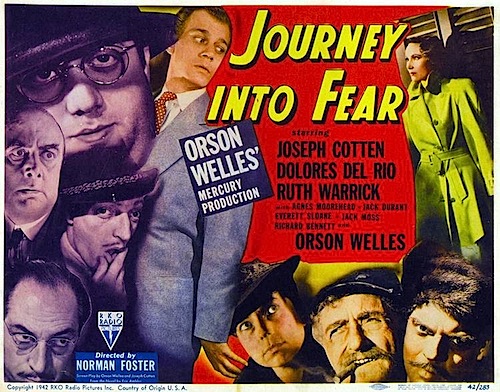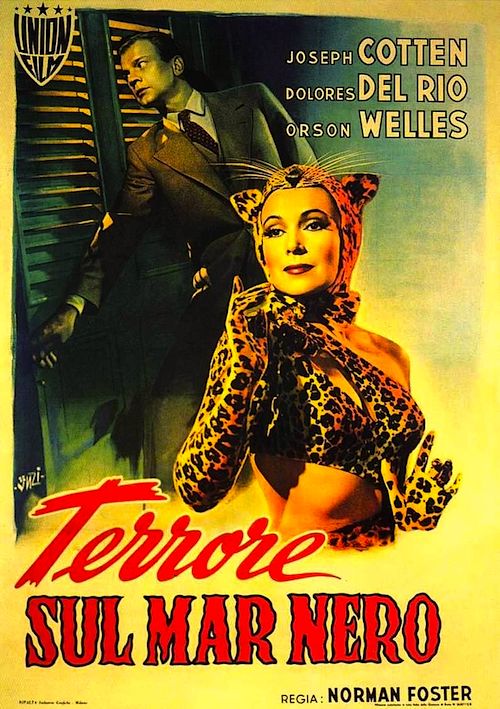 By Joe Bendel. In the Orson Welles’ filmography, this 1943 espionage thriller always has an asterisk next to the title in fans’ minds. Throughout his life, Welles insisted it was directed by his friend Norman Foster, except when discussing the scenes he helmed. Thanks to the misadventure of It’s All True, much of the daily directorial work was indeed left to Foster (who would make a bit of a name for himself with some nifty little noirs), but the Eric Ambler adaptation definitely bears the Welles stamp. Its ragged narrative edges also reflect RKO’s desire to edit it down under seventy minutes. Oh, but there were longer versions screened for preview audiences and European markets. The intrepid Munich Filmmuseum tracked down the various cuts as well as the shooting script to reconstruct a more coherent and surprising funny 81 minute super-cut of Foster’s Journey Into Fear, which screened last night at MoMA as part of the 2015 To Save and Project International Festival of Preservation’s Unknown Welles sidebar.
By Joe Bendel. In the Orson Welles’ filmography, this 1943 espionage thriller always has an asterisk next to the title in fans’ minds. Throughout his life, Welles insisted it was directed by his friend Norman Foster, except when discussing the scenes he helmed. Thanks to the misadventure of It’s All True, much of the daily directorial work was indeed left to Foster (who would make a bit of a name for himself with some nifty little noirs), but the Eric Ambler adaptation definitely bears the Welles stamp. Its ragged narrative edges also reflect RKO’s desire to edit it down under seventy minutes. Oh, but there were longer versions screened for preview audiences and European markets. The intrepid Munich Filmmuseum tracked down the various cuts as well as the shooting script to reconstruct a more coherent and surprising funny 81 minute super-cut of Foster’s Journey Into Fear, which screened last night at MoMA as part of the 2015 To Save and Project International Festival of Preservation’s Unknown Welles sidebar.
It is the early “Phony War” days of WWII, when Britain still expected to forge an alliance with Turkey. It was therefore all fine and dandy that munitions expert Howard Graham was in Istanbul working to rearm the Turkish navy. Graham and his wife Stephanie are due to sail to Batumi (which really doesn’t make sense, since the USSR was allied with Hitler at this time, but so be it), but they will be waylaid by a convoluted conspiracy. Kopeikin, a corrupt representative of Graham’s company drags him to a nightclub, ostensibly to meet the alluring dancer Josette Martel. Through blind luck, Graham escapes an assassination attempt that claims the life of magician Oo Lang Sang instead.
 For his own safety, mind you, Colonel Haki of Turkish intelligence has Graham whisked away on a dodgy tramp steamer, assuring the baffled American he will personally see to his wife’s safety. In fact, one of the rediscovered scenes suggests Haki does indeed give Ms. Graham some ambiguously special attention. (Let’s not forget, Welles was quite the ladies’ man, who was once married to Rita Hayworth. Plus, Haki’s fur hat looks smashing.) Meanwhile, Howard Graham is spending quite a bit of time with Martel on that dodgy steamer, because she is the only passenger he really doesn’t think is out to kill him.
For his own safety, mind you, Colonel Haki of Turkish intelligence has Graham whisked away on a dodgy tramp steamer, assuring the baffled American he will personally see to his wife’s safety. In fact, one of the rediscovered scenes suggests Haki does indeed give Ms. Graham some ambiguously special attention. (Let’s not forget, Welles was quite the ladies’ man, who was once married to Rita Hayworth. Plus, Haki’s fur hat looks smashing.) Meanwhile, Howard Graham is spending quite a bit of time with Martel on that dodgy steamer, because she is the only passenger he really doesn’t think is out to kill him.
Journey has always been an entertaining yarn, but the more complete version makes considerably more sense. Even though the Filmmuseum restoration team was again forced to resort to intertitles in places, the reconstructed preview cut gives us a fuller sense of the wit and irony of the script co-written by Welles and star Joseph Cotton. It is rather delightfully mordant.
As Graham, Cotton prefigures many of the classic everyman Hitchcokian protagonists as well as his turn as Holly Martins in the even more classic The Third Man. He credibly portrays Graham’s evolution from clueless passivity to resentful exasperation. While his screen time as Haki is limited, Welles made the most of it. He was also clearly feeling the power of the hat. Everett Sloane also adds some comedic noir flavor as the dubious Kopeikin, while Dolores del Rio’s Martel brings plenty of femme and a hint of fatale.
What RKO did to their Welles catalog makes you want to pull your hair out. A longer, smoother cut could have become an iconic film, much like Lady from Shanghai and The Third Man. Even with intertitles, the Filmmuseum version is the best way to see it, so hopefully it will be more widely screened in the future. Of course, it is a perfect selection for To Save and Project, which concluded its Unknown Welles sidebar last night at MoMA.
LFM GRADE: A-
Posted on November 23rd, 2015 at 11:57am.